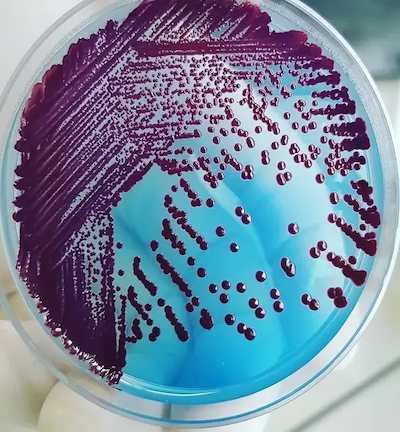Content :
Ⅰ. Overview
Cled agar (Cystine Lactose Electrolyte Deficient ) is differential, non selective culture medium used for the isolation, enumeration and differentiation of urinary microorganisms. It promotes the growth of urinary pathogens, but prevents excessive swarming of Proteus species due to its lack of electrolytes.
The medium allows quantitative determination of urinary pathogens including Proteus when calibrated loops are used for inoculation.

Cled agar
Ⅱ. Preparation / composition
Suspend the components, dehydrated powder, in water (36.13 grams in 1000 ml of purified/distilled water). The medium is boiled for a few seconds until the ingredients are completely dissolved. Mix well and finally sterilize by autoclaving at 121°C for 15 minutes.
Cool to 50-55°C and dispense aseptically into sterile Petri dishes. Date the medium and assign it a lot number.
Cled agar composition |
|||
|---|---|---|---|
| Ingredients | gram/liter | Ingredients | gram/liter |
| Balanced Peptone | 4.0 g | Tryptone | 4.0 g |
| Beef extract | 3.0 g | Lactose | 10.0 g |
| L-Cystine | 0.128 g | Bromothymol Blue | 0.02 g |
| Agar | 15.0 g | Final pH | 7.3 +/- 0.2 |

CLED Agar (Dehydrated)
Ⅲ. Principle of Cled Agar
◈ Originally described by G.H. Sandys in 1960, the medium contains cystine, lactose, bromothymol blue and is electrolyte deficient.
- Cystine is added for the benefit of organisms that have a specific need for cystine. It promotes the growth of coliforms.
- Lactose is included to provide an energy source for organisms capable of utilizing it through a fermentation mechanism.
- Bromothymol blue is the indicator used in the agar, it turns yellow in case of acid production during lactose fermentation or turns dark blue in case of alkalinization. Lactose-positive bacteria form yellow colonies. Bacteria that decarboxylate L-cystine cause an alkaline reaction and form dark blue colonies
- Electrolyte deficiency reduces the invasion of the environment by Proteus.
Ⅳ. Interpretation of Cled Agar
| Bacteria | Growth |
|---|---|
| Escherichia coli, Citrobacte | Yellow colonies, opaque; yellow medium |
| Enterobacter, Klebsiella | Yellow to whitish-blue colonies, often mucoid; yellowish medium |
| Proteus | Translucent blue colonies; blue-green to blue medium |
| Pseudomonas | Green colonies with typical matted surface and rough periphery; blue medium |
| Streptococci | Small, opaque, pale yellow colonies |
| Staphylococci | Very small, opaque, yellow colonies |
| Enterococci | Small yellow colonies, about 0.5 mm in diameter; yellow medium |



Ⅴ. Frequently asked questions
Q : Why CLED agar is electrolyte deficient?
A : CLED agar is electrolyte deficient to prevent excessive swarming of Proteus species. Crisley showed that a strain of Proteus vulgaris grown in the presence of sodium chloride
utilized more glucose and grew to a greater extent than when grown in the absence of sodium chloride.
Naylor showed that this growth enhancement, in the presence of NaCl, is a factor in causing Proteus to swarm.
Q : Is Cled selective?
A : CLED agar is a non-selective medium, It allows the growth of a wide variety of non-fastidious germs
Q : Does Salmonella grow on CLED?
A : Yes, salmonella can grow on CLED, salmonella doesn't utilize lactose (blue-green colonies on the surface of CLED agar).
Q : Why does E coli grow as yellow colonies on CLED?
A : Organisms capable of fermenting lactose, like E coli, will lower the pH and change the color of the medium to yellow (colonies appear yellowish because the agar will turn yellowish)